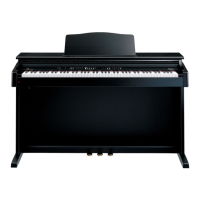How to restore sound on my Roland HP103?
- AAmy LopezAug 21, 2025
To restore sound, first, ensure that the volume level of your Roland HP103 Musical Instrument isn't turned all the way down. Adjust the volume as needed.

How to restore sound on my Roland HP103?
To restore sound, first, ensure that the volume level of your Roland HP103 Musical Instrument isn't turned all the way down. Adjust the volume as needed.
What to do if there is no sound on my Roland HP103?
If no sound comes from your Roland HP103 Musical Instrument, check if headphones are plugged in. When headphones are connected, the keyboard’s speaker stops playing. Also, check for plugs remaining connected to the Phones jack.
How to make the pedal work on my Roland HP103?
To make sure that depressing a pedal has an effect on your Roland HP103 Musical Instrument, verify that the pedal is correctly connected. Ensure the pedal cord is securely connected to the pedal jack on the rear of the unit.
Why doesn't my Roland HP103 power on?
If your Roland HP103 Musical Instrument is not turning on, check if the power cord is correctly connected and plugged in.
How to fix a rattling pedal on my Roland HP103?
If your Roland HP103 Musical Instrument pedal rattles, adjust the adjuster underneath the pedal so that it presses firmly against the floor surface.
What to do if I can't record on my Roland HP103 Musical Instrument?
If you are unable to record on your Roland HP103 Musical Instrument, ensure that one of the track buttons for recording has been selected.
Why is the tempo off on my Roland HP103 Musical Instrument?
If the tempo of your recorded song or metronome is off on your Roland HP103 Musical Instrument and you select an internal song in which the tempo changes during the song and then record, the tempo will change in the same way for the performances. The tempo of the metronome will also change in the same way.
What to do if tempo of recorded song is off on Roland Musical Instrument?
If the tempo of your recorded song or metronome is off on your Roland HP103 Musical Instrument, and you record additional material without erasing the previously recorded song, the song will be recorded at the first-recorded tempo. Erase the previously recorded song before you re-record.
Why doesn't the tone change on my Roland HP103?
If the tone of your Roland HP103 Musical Instrument doesn’t change, the panel or tone might be locked. Turn the power off, then back on. Also, check if the panel or the tone is locked.
What to do if tone doesn't change on my Roland Musical Instrument?
If the tone of your Roland HP103 Musical Instrument doesn’t change, check if the indicators for the [Split] and [Reverb] buttons are flashing. If they are, setting of functions is in progress. Press the [Split] or [Reverb] button to exit function mode.
| Type | Digital Piano |
|---|---|
| Number of Keys | 88 |
| Key Action | Hammer Action |
| Polyphony | 64 voices |
| Effects | Reverb, Chorus |
| Recorder | 1 track, 1 song |
| Pedals | 3 (Damper, Soft, Sostenuto) |
| Speakers | 2 x 12 cm |
| Speaker Power | 20W x 2 |
| Connectivity | MIDI In/Out |
| Keyboard | Progressive Hammer Action Keyboard |
| Touch Sensitivity | 3 levels, fixed |
| Sounds | Piano, Electric Piano, Strings |
| Headphones | 1/4" stereo phone jack |
| Included Accessories | Power cord, Music rest |
Describes the realistic piano sound and polyphony for expressive playing.
Details the progressive hammer action keyboard and pedal response for authentic touch.
Covers essential safety rules for operation, handling, and environmental precautions.
Guidelines for connecting and managing the unit's power supply.
Detailed explanation of buttons, knobs, and indicators on the front panel.
Identifies and explains the rear panel jacks and connectors.
Instructions for connecting pedal cord, power cord, and setting up music rest.
Step-by-step process for turning the piano on and off safely.
How to play back internal songs, including continuous and single song playback.
How to choose tone groups and variation tones for performance.
Guide to changing the keyboard's touch sensitivity settings.
Explanation of the Grand Space function for adding sonic depth.
How to transpose the keyboard's pitch for easier playing or vocal accompaniment.
Guide to layering two tones simultaneously and adjusting their volume balance.
How to divide the keyboard and play different tones in each section.
Step-by-step guide to recording your own keyboard performance.
How to record performances while playing along with internal songs.
Recording left and right hands on separate tracks.
